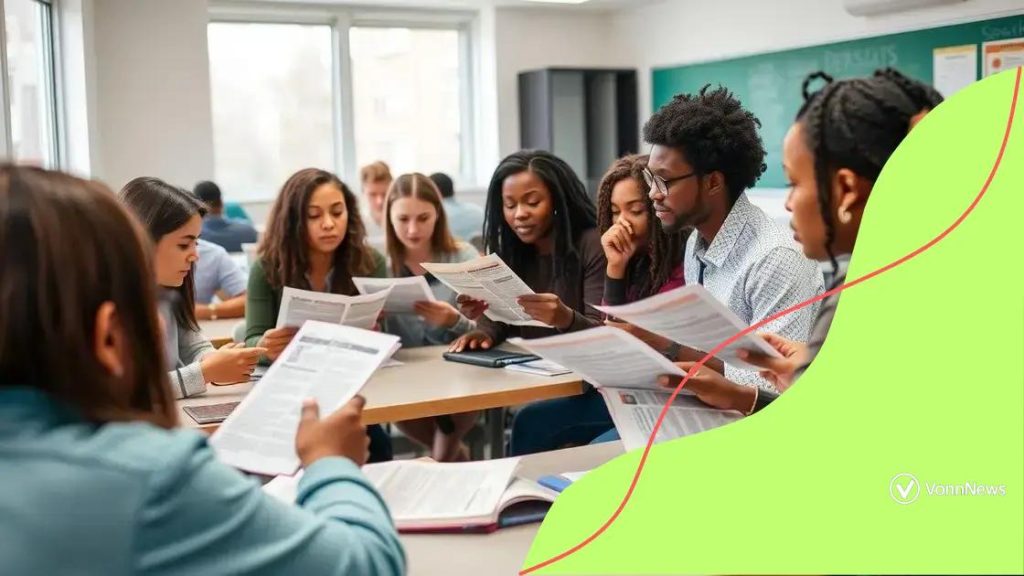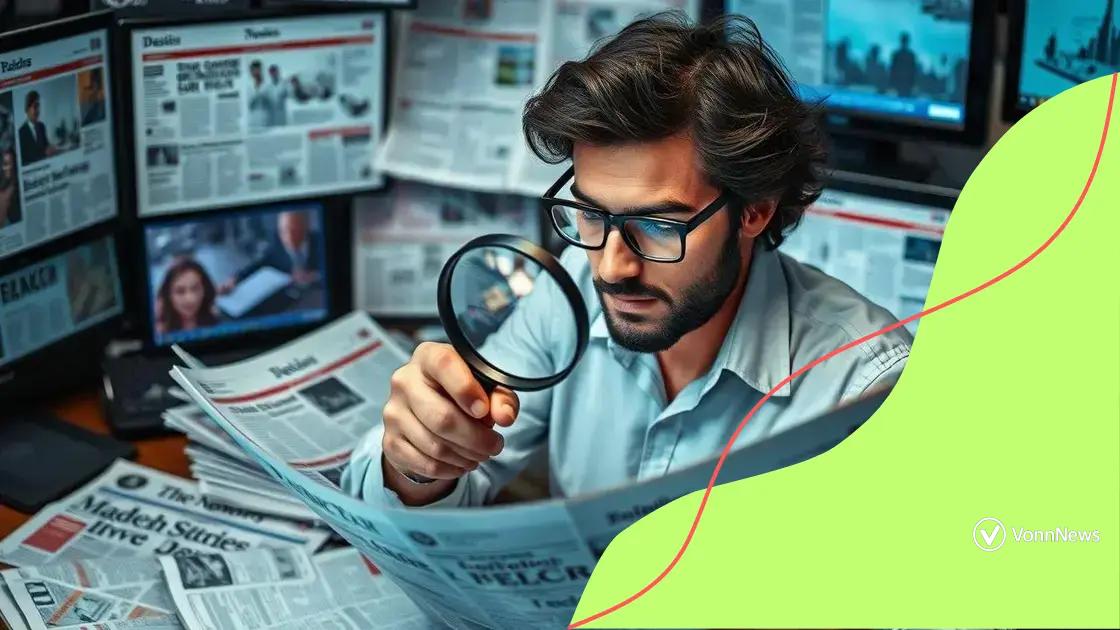Media bias awareness education: why it matters

Anúncios
Media bias awareness education equips individuals with critical thinking skills to analyze and evaluate media sources, promoting informed consumption and healthier public discourse.
Media bias awareness education is essential in today’s information-driven society. It helps individuals discern the subtle influences in news coverage that shape our understanding of the world. As we delve into this topic, consider how often your perspective is swayed by the media.
Anúncios
Understanding media bias: definitions and implications
Understanding media bias is crucial for recognizing its impact on society. It refers to the slanting or favoritism in news reporting, which can shape public views and opinions. By identifying media bias, we become more informed consumers of news.
Types of Media Bias
There are several types of media bias that can be observed in news coverage:
- Selection Bias: Focusing on certain stories while ignoring others can influence what audiences perceive as important.
- Confirmation Bias: This occurs when outlets highlight information that supports a specific viewpoint, reinforcing existing beliefs.
- Source Bias: Favoring certain sources over others might lead to skewed reporting.
- Framing Bias: The way issues are presented can shape audience reactions significantly.
Recognizing these biases involves critically analyzing the sources of information. Questions you can ask include: Who is presenting the information? What perspectives are highlighted or omitted? Understanding these aspects can vastly improve our media literacy.
Implications of Media Bias
The implications of media bias are vast. It can lead to a misinformed public, polarized opinions, and increased distrust in media outlets. When individuals receive skewed information, they may make decisions based on incomplete or biased data.
Anúncios
Moreover, media bias can distort the reality of important events, leading to conflicting narratives within the public discourse. It reinforces division by promoting echo chambers, where individuals only engage with viewpoints that align with their own.
To combat this, fostering a culture of media literacy is vital. By teaching individuals how to critically evaluate news, they can navigate biases more effectively, leading to healthier public discourse.
Incorporating diverse sources of information helps to mitigate the effects of media bias. Engaging with various viewpoints encourages a more rounded understanding of issues, allowing for informed discussions and ultimately, a more informed society.
The impact of media bias on public perception
The impact of media bias on public perception is significant and multifaceted. When news is presented with a slant, it can alter how people understand important issues. Through biased reporting, certain narratives can dominate, leading audiences to form opinions based on incomplete or skewed information.
Shaping Opinions
Media bias often shapes opinions by emphasizing specific facts while downplaying others. For instance, coverage of political events can focus on certain candidates’ weaknesses, while neglecting their strengths. This selective reporting creates an imbalanced view.
- Example: If a news outlet predominantly highlights negative stories about a politician, it can influence public perception negatively.
- Influence on Choices: Media portrayal affects how individuals vote, purchase products, or engage in discussions.
- Polarization: Biased coverage can deepen divides among groups by presenting conflicting narratives.
As media consumers, it’s vital to question the information presented. Consider where the news comes from and what perspectives are being shown. This scrutiny helps individuals recognize media bias and its effects.
Long-term Effects
Over time, repeated exposure to biased content can lead to a distorted worldview. People may start to believe that only certain viewpoints are valid, dismissing alternate perspectives as invalid or unworthy of consideration. This phenomenon reinforces existing beliefs and can create echo chambers, where individuals only engage with like-minded information.
Moreover, the resulting mistrust in media sources can erode the foundation of a democratic society. When citizens are unable to agree on basic facts due to biases, productive dialogue becomes challenging. Fostering understanding and critical thinking can counter these trends and promote a more informed public.
Techniques to recognize media bias in reporting

Recognizing media bias in reporting is essential for becoming an informed consumer of news. It enables individuals to critically assess the information they receive. Here are some techniques to help identify bias in the media.
Examine the Headlines
The headline of an article often sets the tone for how the story is perceived. Look for sensational language or emotional triggers. Headlines that provoke strong reactions can indicate a biased approach.
- Exaggerated Claims: Be wary of headlines that make big promises or sensationalize facts.
- Loaded Language: Notice adjectives that convey judgement rather than neutrality.
- Partial Information: Check if the headline reflects the entire story or just a part of it.
Recognizing bias also involves analyzing the source of the information. Research the background of the media outlet. Check for possible affiliations that may influence their reporting.
Assess the Use of Sources
Another important technique is to evaluate the sources used in the article. Reliable reporting typically includes diverse perspectives. When a story features only one side, it may reflect media bias.
- Source Diversity: Reliable articles should cite multiple experts or individuals from different backgrounds.
- Transparency: Check if the sources are named and if their credentials are provided.
- Questionable Sources: Be cautious of articles referencing unknown or unverified sources.
Reading beyond the first few paragraphs is crucial. Early biases may not be as noticeable. Full context is required for a clear understanding.
Look for Balance and Fairness
Examine if the article presents both sides of an argument fairly. A balanced piece of reporting will include counterarguments or different viewpoints. If one side is heavily favored, it may reflect bias.
Engaging in discussions with others about articles can also help. Sharing thoughts and opinions allows for different interpretations to surface. This practice can enhance critical thinking skills, making it easier to identify bias.
Ultimately, taking time to assess news critically empowers individuals. Recognizing media bias helps foster informed discussions and broadens understanding of complex issues.
Promoting media literacy in educational settings
Promoting media literacy in educational settings is vital for preparing students to navigate today’s complex media landscape. By incorporating media literacy into the curriculum, educators can equip students with the skills needed to critically analyze information.
Integrating Media Literacy into the Curriculum
Teachers can introduce media literacy as a subject or integrate it into existing subjects. This approach helps students recognize the influence of media on their lives.
- Critical Thinking Exercises: Include activities that encourage students to analyze news articles and advertisements.
- Debate Activities: Organize debates on current events, helping students understand multiple perspectives.
- Project-Based Learning: Assign projects where students create their own media, promoting an understanding of production techniques.
Working with parents and the community can further enhance media literacy initiatives. Hosting workshops where parents learn about media literacy can create a supportive environment.
The Role of Technology
Technology integration plays a crucial role in promoting media literacy. Teaching students how to use digital tools responsibly empowers them to engage with media effectively. Understanding how to assess online sources is just as critical as evaluating print media.
Additionally, exploring online platforms can help students learn about biased reporting. Social media, blogs, and news sites often present information in different ways. This exploration can encourage students to question the reliability of sources they encounter.
Continuous Learning and Assessment
Promoting media literacy doesn’t stop once students leave the classroom. Continuous learning is key. Schools can offer ongoing workshops or resources for students and parents. Educators should also assess the effectiveness of their media literacy programs regularly.
By fostering a culture of inquiry around media literacy, schools can help students develop essential skills that will benefit them throughout their lives. These skills will enable them to make informed decisions and become responsible consumers of media.
Strategies for fostering objective media consumption
Fostering objective media consumption is vital for building informed citizens. Learning to engage critically with media helps individuals discern facts from opinions. Here are several strategies to encourage this behavior.
Encourage Critical Thinking
One of the most effective strategies for promoting objective media consumption is to encourage critical thinking. Students and consumers should be taught to question what they read and hear. This can include:
- Asking Questions: Encourage them to ask who created the content, what the purpose is, and who benefits from it.
- Identifying Bias: Teach how to spot possible bias in language and framing, which can influence perceptions.
- Fact-checking: Promote the use of reputable fact-checking websites to verify information.
By fostering a mindset of inquiry, individuals can approach media more thoughtfully.
Diversity of Sources
Another strategy is promoting exposure to a variety of media sources. This helps individuals to see different angles of stories and encourages a more balanced understanding. Here are some suggestions:
- Consume Diverse Perspectives: Encourage reading news from various outlets, including local, national, and international sources.
- Explore Multiple Platforms: Suggest using different types of media, such as podcasts, documentaries, and blogs.
- Engage in Discussions: Create opportunities for open conversations about differing viewpoints, enhancing critical dialogue.
Access to a broad range of perspectives can challenge assumptions and reduce bias.
Digital Literacy Education
Education systems can play a significant role in promoting objective media consumption. Teaching digital literacy helps individuals navigate the vast information landscape. This education can include:
- Recognizing Reliable Sources: Help students learn how to identify credible websites and reputable authors.
- Avoiding Misinformation: Training on how to spot misleading information or deepfake content is crucial.
- Understanding Algorithms: Discuss how algorithms shape the news feed on social media platforms, influencing what information they see.
By understanding these elements, students can become more discerning consumers of information.
FAQ – Frequently Asked Questions about Media Literacy
What is media literacy?
Media literacy is the ability to access, analyze, evaluate, and create media in various forms. It helps individuals understand how media influences perceptions and behaviors.
Why is promoting media literacy important?
Promoting media literacy is important because it empowers individuals to become critical consumers of information, making informed decisions in an increasingly complex media landscape.
How can I encourage critical thinking in media consumption?
Encouraging critical thinking can be done by teaching individuals to ask questions about the sources, motives, and context of the media they consume.
What role do schools play in media literacy education?
Schools play a crucial role by integrating media literacy into the curriculum, teaching students how to evaluate sources and understand the impact of media on society.